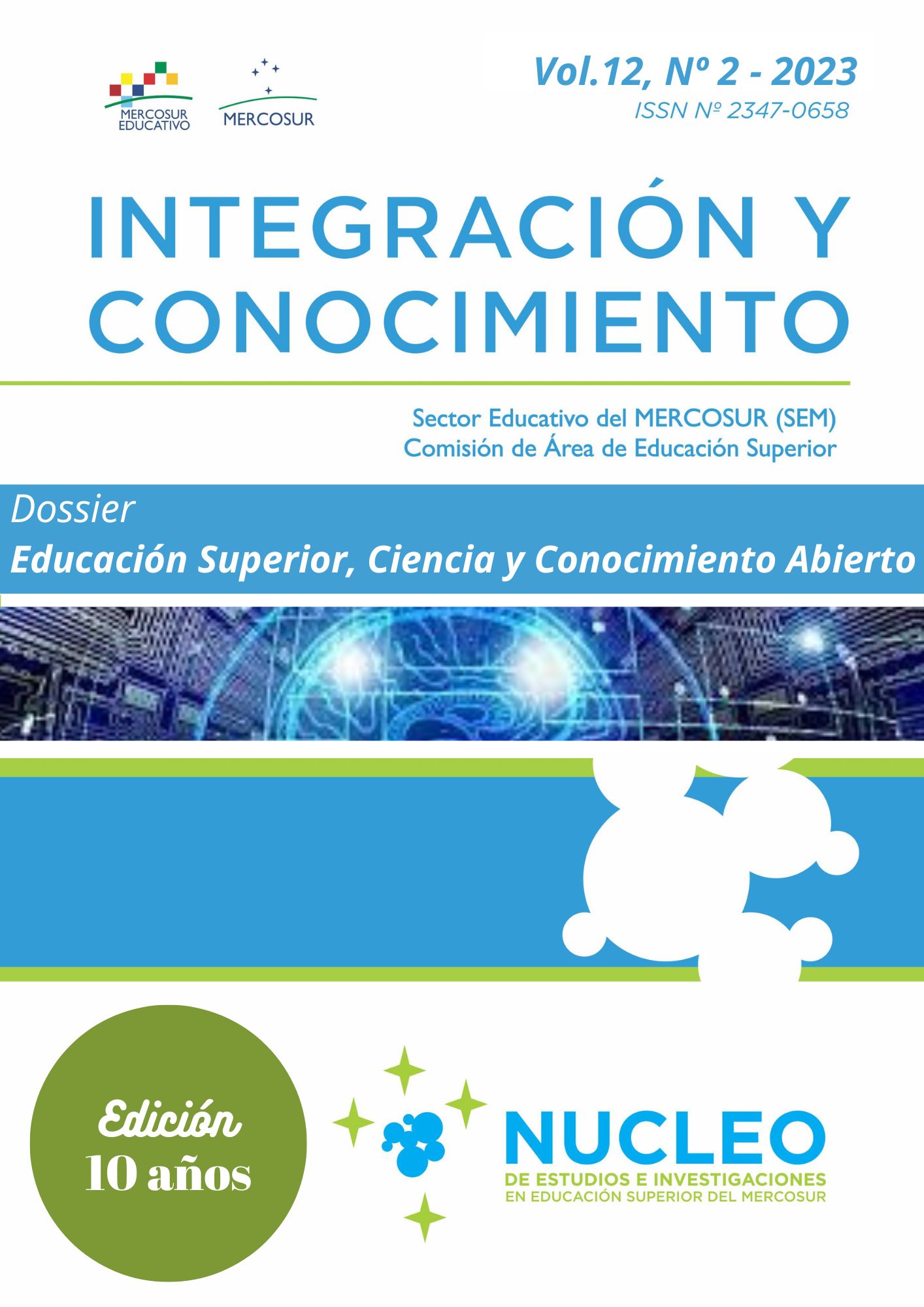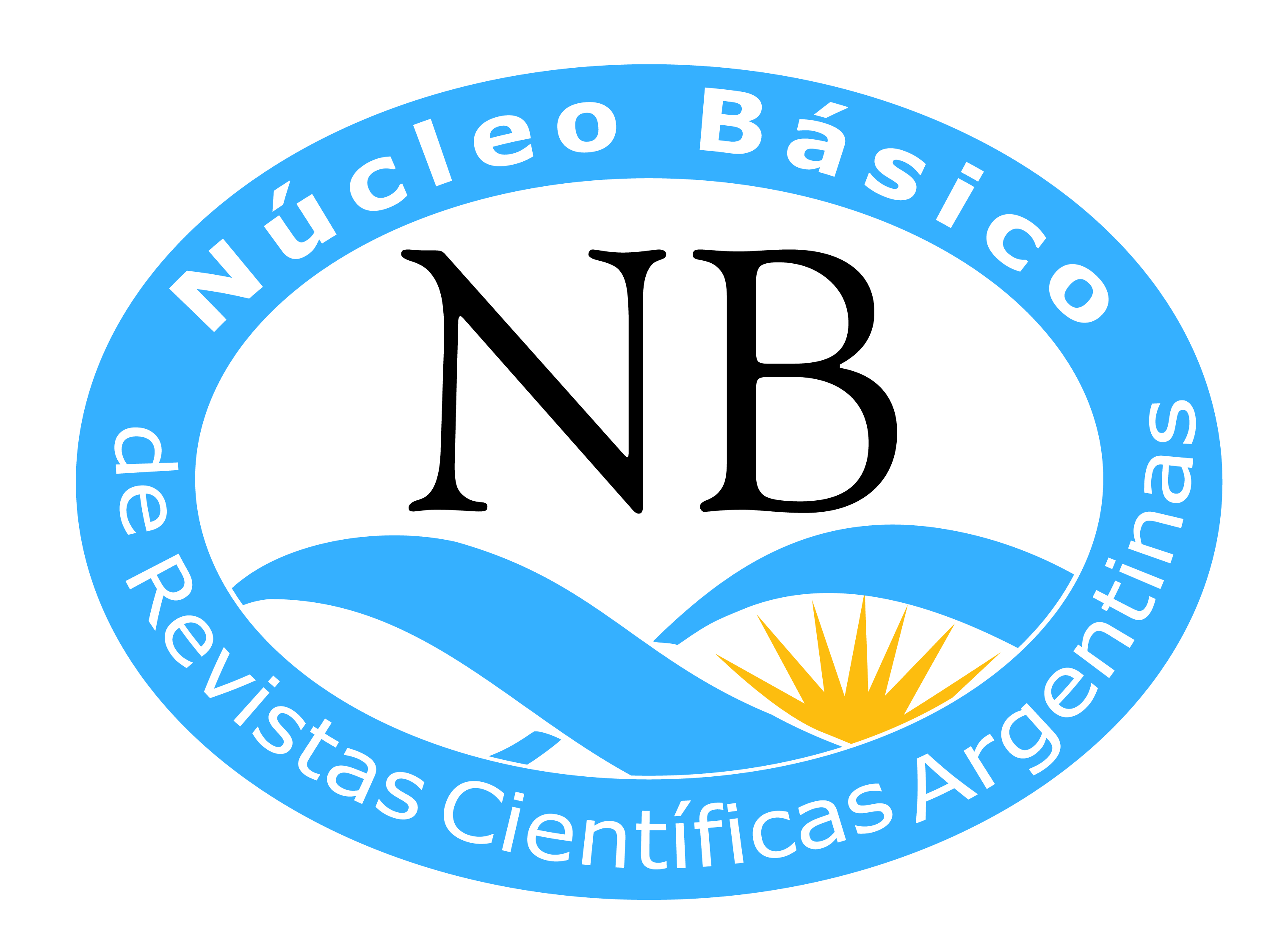Overview of latin american scientific production in open science: analysis from Scopus in the period 2000-2022
DOI:
https://doi.org/10.61203/2347-0658.v12.n2.42031Keywords:
Open Science; Scientific production; Latin America; Metric Studies of Information.Abstract
Academic research on open science has grown strongly in recent years, as indicated by previous studies. This work aims to characterize the scientific production of Latin America (LA) on open science, according to its main components, and from publications indexed in Scopus, with at least one author linked to a Latin American institution (between 2000 and 2022). It is a descriptive research, which uses the quantitative methodological approach provided by the Information Metric Studies. The analyses carried out on the documentary corpus are: diachronic evolution of publications in Latin America and the world; their distribution by country and by affiliation institution; identification of international collaboration and institutional elite; distribution by thematic category of Scopus and analysis of co-occurrence of terms. The results allow us to observe the growth of scientific production, the importance of international collaboration, the prominence of university institutions and the main topics addressed. This characterization allows us to draw an overview of how the scientific production on open science in Latin America is positioned, some of its specificities and its evolution in the period considered.
Downloads
References
Abadal, E. y Anglada, L. (2020). Ciencia abierta: cómo han evolucionado la denominación y el concepto. Anales de Documentación, 23(1). Recuperado de:
https://doi.org/10.6018/analesdoc.378171
BOAI. (2002). Budapest Open Access Initiative. Recuperado de:
http://www.budapestopenaccessinitiative.org/read
Beaver, D. de B. y Rosen, R. (1978). Studies in scientific collaboration. Part 1. The professional origins of scientific co-authorship. Scientometrics, 1(1),65–84. Recuperado de: https://doi.org/10.1007/BF02016840
Beaver, D. de B. y Rosen, R. (1979a). Studies in scientific collaboration. Part 2. Scientific co-authorship, research productivity and visibility in the French elite, 1799 - 1830. Scientometrics, 1(2), 133–149. Recuperado de: https://doi.org/10.1007/BF02016966
Beaver, D. de B. y Rosen, R. (1979b). Studies in scientific collaboration. Part 3. Professionalization and the natural history of modern scientific co-authorship. Scientometrics, 1(3), 231–245. Recuperado de: https://doi.org/10.1007/BF02016308
Callon, M., Courtial, J. P. y Laville, F. (1991). Coword analysis as a tool for describing the network of interactions between basic and technological research: the case of polymer chemistry. Scientometrics, 22(1), 155-205. Recuperado de: https://doi.org/10.1007/BF02019280
Cano Menoni, A. y Castro Vilaboa, D. (2016). La extensión universitaria en la transformación de la educación superior. El caso de Uruguay. Andamios, 13(31), 313-337.
Castillo, J. A. y Powell, M. A. (2019). Análisis de la producción científica del Ecuador e impacto de la colaboración internacional en el periodo 2006-2015. Revista Española de Documentación Científica, 42(1), e225. Recuperado de: https://doi.org/10.3989/redc.2019.1.1567
David, P. A. (2003). The economic logic of “open science” and the balance between private property rights and the public domain in scientific data and information: A primer. En: P. Uhlir & J. Esanu (Eds.), National Research Council on the Role of the Public Domain in Science (pp. xx-xx). Washington, DC: National Academy Press. Disponible en: https://www.ncbi.nlm.nih.gov/books/NBK221855/
De Filippo, D. y D’Onofrio, M. G. (2019). Alcances y limitaciones de la ciencia abierta en Latinoamérica: análisis de las políticas públicas y publicaciones científicas de la región. Hipertext.net, (19), 32-48. Recuperado de:
https://doi.org/10.31009/hipertext.net.2019.i19.03
Fecher, B. y Friesike, S. (2014). Open Science: one term, five schools of thought. En: Bartling, S. y Friesike, S. (eds.), Opening science: the evolving guide on how the Internet is changing research, collaboration and scholarly publishing (pp-xx-xx) Londres: Springer.Recuperado de: https://doi.org/10.1007/978-3-319-00026-8
Foster. (2018). Open science taxonomy. Disponible en: https://www.fosteropenscience.eu/foster-taxonomy/open-access
Freeman, Linton C. (2012). El desarrollo del Análisis de Redes Sociales: un estudio de Sociología de la Ciencia. Bloomington: Palibrio.
Huutoniemi, K., Klein, J. T., Bruun, H. y Hukkinen, J. (2010). Analyzing interdisciplinarity. Typology and indicators. Research Policy, 39(1), 79–88. Recuperado de: https://doi.org/10.1016/j.respol.2009.09.011
Kaplún, G. (2014). La integralidad como movimiento instituyente en la universidad. InterCambios. Dilemas y transiciones de la Educación Superior, 1(1), 44-51. Recuperado de: https://ojs.intercambios.cse.udelar.edu.uy/index.php/ic/article/view/11
Klein, J. T. (1990). Interdisciplinarity. History, theory and practice. Detroit, EE.UU.: Wayne State University Press.
Klein, J. T. (2011). A taxonomy of interdisciplinarity. En: R. Frodeman, J. T. Klein y C. Mitchan (Eds.), The Oxford Handbook of Interdisciplinarity (pp.15- 30). Oxford, Inglaterra: Oxford University Press.
Lucas, E. de O., Garcia-Zorita, J. C., y Sanz-Casado, E. (2013). Evolução histórica de investigação em informetria: ponto de vista espanhol. Liinc Em Revista, 9 (1), pp-pp Recuperado de: https://doi.org/10.18617/liinc.v9i1.509
Open Knowledge Foundation, (s.d.) Open definition:defining open in open data, open content and open knowledge. Recuperado de: https://opendefinition.org/od/2.1/es/
Price, D.S. (1963). Big science, little science. Columbia University, New York.
Price, D.S. (1976). O desenvolvimento da ciência. Rio de Janeiro: Livros técnicos e Científicos.
Pontika, N., Knoth, P., Cancellieri, M., y Pearce, S. (Octubre, 2015). Fostering Open Science to Research Using a Taxonomy and an eLearning Portal. Trabajo presentado en: I-KNOW ’15: Proceedings of the 15th International Conference on Knowledge Technologies and Data-Driven Business, New York, NY, USA.Recuperado de: https://doi.org/10.1145/2809563.2809571
Ramírez, P.A. y Samilovich, D. (2021). Ciencia abierta en América Latina. UNESCO. Recuperado de: http://forocilac.org/wp-content/uploads/2022/03/PolicyPapers-CienciaAbierta-ES-v2.pdf
Schlagwein, D., Conboy, K., Feller, J., Leimeister, J. M., y Morgan, L. (2017). Openness with and without Information Technology: A Framework and a Brief History. Journal of Information Technology, 32(4), 297-305. Recuperado de: https://doi.org/10.1057/s41265-017-0049-3
Turpo-Gebera, O., Limaymanta, C. H., y Sanz-Casado, E. (2021). Producción científica y tecnológica de Perú en el contexto sudamericano: Un análisis cienciométrico. Profesional de la información, 30(5), pp-ppRecuperado de: https://doi.org/10.3145/epi.2021.sep.15
UNESCO. (2021). Recomendación de la UNESCO sobre la Ciencia Abierta. Recuperado de: https://unesdoc.unesco.org/ark:/48223/pf0000379949_spa
Vicente-Saez, R., y Martinez-Fuentes, C. (2018). Open Science now: A systematic literature review for an integrated definition. Journal of Business Research, 88, 428–36. Recuperado de: https://doi.org/10.1016/j.jbusres.2017.12.043
Downloads
Published
Issue
Section
License
Copyright (c) 2023 Integración y Conocimiento

This work is licensed under a Creative Commons Attribution-NonCommercial-ShareAlike 4.0 International License.
Authors who have publications with this journal accept the following terms:
a. Authors shall retain their copyright and guarantee the journal the right of first publication of their work, which shall simultaneously be subject to the Creative Commons License of Recognition which allows third parties to share the work as long as its author is indicated and its first publication is this journal.
b. Authors may adopt other non-exclusive licensing agreements for the distribution of the published version of the work (e.g., depositing it in an institutional telematic archive or publishing it in a monographic volume) provided that the initial publication in this journal is indicated.
c. Authors are allowed and encouraged to disseminate their work via the Internet (e.g. in institutional telematic archives or on their website) after publication of the article, which may lead to interesting exchanges and increased citations of the published work. (See The Effect of Open Access).



